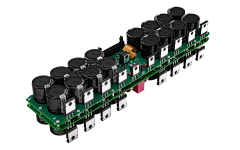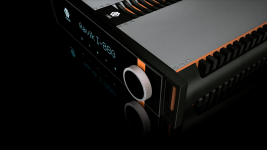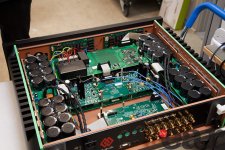Hi all,
I have had a chance to attend PAF convention where I gave a listen to this amplifier by Audio Group Denmark, and in my opinion it sounded better then all others. Official website has few pictures of the inside and describes it as Class A, but only biased when needed. To me the board looks like Class AB, just overbiased. Wondering if it is possible to determine such things from the picture of PCB?
I have had a chance to attend PAF convention where I gave a listen to this amplifier by Audio Group Denmark, and in my opinion it sounded better then all others. Official website has few pictures of the inside and describes it as Class A, but only biased when needed. To me the board looks like Class AB, just overbiased. Wondering if it is possible to determine such things from the picture of PCB?
Attachments
From the official website:
Aavik 200W pure class A amplifier
Aavik have designed a circuitry that constantly keeps the bias spread 0,63 V above the required current, no matter where it is in the cycle. So, no matter how much current the power amp requires to perform, it always stays in Class A up to an impressive 2×200 W into 8 ohms, while at the same time not consuming unnecessary power.
This significant reduction in the power requirements of the amplifier allowed Aavik to design the capacitors as smaller units and place them locally, so that essentially each of the eight pairs of output transistors has its own capacitor bank right next to it. This means that the current does not have to flow through long wire harnesses and long circuit boards. The current is always directly at the output transistor, which means a shorter signal path and therefore less noise. In addition, this innovative Aavik design also means that the 880 amplifiers do not get as hot as conventional Class A amplifiers, resulting in higher efficiency.
Aavik 200W pure class A amplifier
Aavik have designed a circuitry that constantly keeps the bias spread 0,63 V above the required current, no matter where it is in the cycle. So, no matter how much current the power amp requires to perform, it always stays in Class A up to an impressive 2×200 W into 8 ohms, while at the same time not consuming unnecessary power.
This significant reduction in the power requirements of the amplifier allowed Aavik to design the capacitors as smaller units and place them locally, so that essentially each of the eight pairs of output transistors has its own capacitor bank right next to it. This means that the current does not have to flow through long wire harnesses and long circuit boards. The current is always directly at the output transistor, which means a shorter signal path and therefore less noise. In addition, this innovative Aavik design also means that the 880 amplifiers do not get as hot as conventional Class A amplifiers, resulting in higher efficiency.
The word "pure" here is at odds with the design description.
Ok....bias spread 0,63 V above the required current. That sounds like some sort of sliding bias which is a well known technique for years...
My Yamaha P2500S and P3500S PA amplifiers also apply sliding bias to raise efficiency and keep the amplifiers cool (important for PA duty).
Nowadays, class D amplifiers are popular for unclear reasons wrt audio, apart from that "efficiency" thing.
I visited Audio Group Denmark exhibition at Hi End Munich last month. They must excel in PR which seems necessary to market a 50k+ euro amplifier 🤢
My Yamaha P2500S and P3500S PA amplifiers also apply sliding bias to raise efficiency and keep the amplifiers cool (important for PA duty).
Nowadays, class D amplifiers are popular for unclear reasons wrt audio, apart from that "efficiency" thing.
I visited Audio Group Denmark exhibition at Hi End Munich last month. They must excel in PR which seems necessary to market a 50k+ euro amplifier 🤢
I think Bruno Putzeys and his Purify amps has something to do with class D gaining popularity.Nowadays, class D amplifiers are popular for unclear reasons
Overall, I liked the sound of speakers that Audio group Denmark presented - even though the price tag for those was $550,000. Planar tweeter sounded just exceptionally.
Funny that they also had another set of speakers displayed - “budget” version for $11,000 with the same tweeter. In my opinion sound was identical between those two lol.
I also liked Pass Labs gear for its sound. If I had money to spare, I would pair Pass labs amp with AGD 11k speakers and call it good.
I like the fact that the power supply capacitors are placed so close to the output transistors.
What is unclear is the technology they used in the pre-amp section.
The ability to choose just the right gain for individual needs is really welcomed.
Anything they can do to boost the class A efficiency above 10%.... is phenomenal.
Of course, at the end of the day, if that amp can portray natural harmonics, depth, and width... and make the soundscape believable and true to what you expect to hear in real life (like... you can walk inside the room and approach each individual instrument).... then kudos are in order.
What is unclear is the technology they used in the pre-amp section.
The ability to choose just the right gain for individual needs is really welcomed.
Anything they can do to boost the class A efficiency above 10%.... is phenomenal.
Of course, at the end of the day, if that amp can portray natural harmonics, depth, and width... and make the soundscape believable and true to what you expect to hear in real life (like... you can walk inside the room and approach each individual instrument).... then kudos are in order.
I wonder if those are just decoupling capacitors? Seems like power supply is a separate unit… I might be mistaken thoughI like the fact that the power supply capacitors are placed so close to the output transistors
That is the power/calories available for the output transistors. I do not know if that amp has a separate PS PCB, though.
Nevertheless, in general, I like this approach specifically because of all the unknowns associated with a conventional design, where the power supply capacitor bank is located away from AMP PCB, and in particular....
... the wiring length, wiring type, wire diameter, capacitance used on the PS PCB (amount, type), PS PCB design (tracks geometry, thickness)
are simply placed outside of the equation that has to ensure a uniform, low, broad frequency spectrum.... power supply/rails' impedance... available right where it is needed.
Nevertheless, in general, I like this approach specifically because of all the unknowns associated with a conventional design, where the power supply capacitor bank is located away from AMP PCB, and in particular....
... the wiring length, wiring type, wire diameter, capacitance used on the PS PCB (amount, type), PS PCB design (tracks geometry, thickness)
are simply placed outside of the equation that has to ensure a uniform, low, broad frequency spectrum.... power supply/rails' impedance... available right where it is needed.
Sorry to be a Dane, when this kind of overprised nonsense hits the market.
No matter how you implement it,........ A powersupply tracing signal peaks will always be slower than the signal itself.
In other words, this as far as you can get from Pure "Class A".
Technics and JVC did this in the 80´s (Class AA & Super A) without being dishonest and trying to claim Pure Class A.
Yet 40-50 years later up pops a company claiming to have invented the wheel.
What could one expect from people, who charge 4000$ for a metal rod to place on your equipment, or a power cable for the
price of 22.000 Euro´s and upwards.
Just rediculous behaviour to rid you of your money.
Even more sad was to see Flemming Rasmussen (founder of Gryphon) retire and join Audio Group Denmark 🙁
No matter how you implement it,........ A powersupply tracing signal peaks will always be slower than the signal itself.
In other words, this as far as you can get from Pure "Class A".
Technics and JVC did this in the 80´s (Class AA & Super A) without being dishonest and trying to claim Pure Class A.
Yet 40-50 years later up pops a company claiming to have invented the wheel.
What could one expect from people, who charge 4000$ for a metal rod to place on your equipment, or a power cable for the
price of 22.000 Euro´s and upwards.
Just rediculous behaviour to rid you of your money.
Even more sad was to see Flemming Rasmussen (founder of Gryphon) retire and join Audio Group Denmark 🙁
They write "Pure Class A" -Not Class A, so they are not being dishonest 🙂 Gryphon is good, but wildly overprised gear as well isn`t it? I learned about it in school. Rich people dont want to buy an amp for 10000 dollars no mattter how good it is if they can buy one in a bigger enclosure for 20000. Its called psychological prizing. Same as us poor people buy anything that cost 9.99, but 10.20 is WAY too expensive.
Cheers!
Cheers!
I see the 2X SIP connector. That looks like just a output stage. Input stage connects with a flat cable.Wondering if it is possible to determine such things from the picture of PCB?
Vbe present means it is a class AB. Connector could also be for the protection circuit.
OS
Non-switching class AB (at best). Technically , it is class A - never switches. I've designed these , could not tell the difference from a quality AB EF3.Aavik have designed a circuitry that constantly keeps the bias spread 0,63 V above the required current, no matter where it is in the cycle. So, no matter how much current the power amp requires to perform, it always stays in Class A up to an impressive 2×200 W into 8 ohms, while at the same time not consuming unnecessary power.
"Real" (true) class A will typically use MOSFET's and have huge heatsinks. 50W class A will have the same thermal solution as a 250W AB.
OS
Spot on - Aavic 880 IS a OPS/separate IPS non-switching "fancy" amp ! Such a small return for the perverse complication of the circuit-layout.
Bet the forum wolverine or my "mini" with a standard EF3 would match it's SQ (for <100$).
Blasphemy !! They use a resonant SMPS (cpu controlled) to power those big OPS filter banks .... silver , beryllium , and copper to fool the
"audiophools" ... cool ...
OS
Bet the forum wolverine or my "mini" with a standard EF3 would match it's SQ (for <100$).
Blasphemy !! They use a resonant SMPS (cpu controlled) to power those big OPS filter banks .... silver , beryllium , and copper to fool the
"audiophools" ... cool ...
OS
Attachments
- Home
- Amplifiers
- Solid State
- Aavik I-880 by Audio Group Denmark amplifier board design question - Class A or Class AB??


